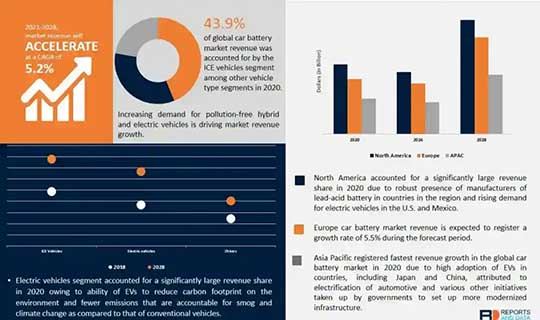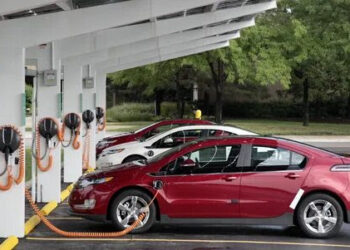New York –The global car battery market size is expected to reach USD 92.60 Billion in 2028 and register a revenue CAGR of 5.2% over the forecast period, according to the latest report by Reports and Data. Increasing demand for pollution-free hybrid and electric vehicles is driving market revenue growth. Reduction in crude oil reserves, fall in battery prices, and increasing concerns regarding the environment is another factor driving revenue growth of the global car battery market.
Increase in production and sale of vehicles, rising demand for advanced technologies, and changing lifestyle are some other factors fueling market revenue growth. Electric vehicle manufacturers are focusing on installing batteries with adequate power and reserve capacity to drive sales and attract more customers. Moreover, increasing investment in research and development of electric vehicles is expected to provide ample growth opportunities for players operating in the global car battery market in the coming years.
COVID-19 has affected market growth negatively due to continuous lockdown in most parts of the world and halt in production of car batteries. The pandemic also highlighted dependence of manufacturing battery cells on China and the risks associated with it. Market players are beginning to move their manufacturing plants more lucrative regions and countries, thereby paving way for new opportunities for other countries.
Rechargeable batteries play a significant role in lowering carbon footprint and mitigating greenhouse gas emissions, which is also propelling market growth. Another driving factor of car batteries market is increasing demand for electric vehicles.

Request Sample of this report: https://www.reportsanddata.com/sample-enquiry-form/4173
Some Key Highlights from the Report
- In July 2021, Nissan announced plans to build its first car battery ‘gigafactory’, in the UK, where it will build a new electric vehicle. Envision AESC, Nissan’s Chinese battery supplier, is set to invest over USD 600 million to build the battery plant that will run on renewable energy and can power up to 100,000 Nissan electric vehicles every year. The facility will be built in Sunderland and is considered a significant step towards fossil fuel-free vehicles.
- Lithium-ion based battery segment revenue is expected to register a rapid growth rate during the forecast period. These battery types charge faster, have high power density, and last longer. Lithium-ion based battery has emerged as an eco-friendly rechargeable power source as compared to traditional or conventional batteries. Majority of electric vehicles run on lithium-ion batteries and ongoing R&D to reduce costs will further drive revenue growth of this segment.
- Electric vehicles segment accounted for a significantly large revenue share in 2020 as these vehicles have smaller carbon footprint, have less impact on the environment, and release fewer emissions that are accountable for smog and climate change as compared to conventional vehicles. Countries such as Norway, Germany, China, and the UK, among others, are rapidly switching to electric vehicles thus encouraging automotive manufacturers to make significant investments in the car battery market and expand business opportunities and revenues.
- Asia Pacific registered fastest revenue growth rate in 2020 due to high adoption of electric vehicles in countries, including Japan and China, attributed to the automotive electrification initiatives and government initiatives to set up more advanced infrastructure. Additionally, countries such as India and South Korea are taking initiatives to decrease greenhouse gas emissions by supporting demand for electric vehicles and government schemes that are favorable. This is driving growth of the car battery market in the region.
- Major players in the market include Exide Technologies, A123 Systems, LLC, Enersys, Hitachi, Ltd., GS Yuasa Corporation, LG Chem Ltd., BYD Co. Ltd., NEC Corporation, Samsung SDI Co., Ltd., and LG Chem Ltd.













